In many instances, herbicide injury could occur on non-target crop due to herbicide misapplication or off-target movement (drift, volatility, leaching, etc.). Herbicide injury is also observed in certain crops from application of the labeled herbicide, but this injury symptom is transient and crop recovers in a short time period without compromising yield. Diagnosing crop injury symptoms accurately is often difficult because of the complex nature of crop production systems where various factors (disease, insects, nutrients, moisture) can interact for developing symptoms. Proper record keeping of field activities and spray applications is very helpful for diagnosing crop injury symptoms. This publication aims to provide information on peanut injury symptoms related to various herbicide modes of action and help in identifying general injury symptoms associated with certain herbicide mode of action groups.
1) Photosynthesis Inhibitors (Group 5, 6, or 7)
Mechanism of Action: Photosynthesis inhibitors block the electron flow after the leaf absorbs light energy. As a result, the chloroplast is unable to process the absorbed light energy, and energy buildup occurs. This massive energy buildup eventually causes cell membranes to rupture and the surrounding plant tissues to die.
Behavior in Plants: Most of these herbicides have significant soil activity and are applied preemergence (PRE). The herbicide is absorbed by roots and moves upward to the shoots through xylem following the water pathway. The herbicide accumulates in the leaf, particularly in the margin. Some of these herbicides can be applied postemergence (POST). In this case, the herbicide only acts on the plant tissue that it contacts and does not move to other parts of the plant.
Symptoms: When applied PRE, the injury symptoms on susceptible plants begin with chlorosis, or yellowing, of the leaves between leaf veins, then yellowing at the margins followed by tissue death. Older leaves are more affected than newer leaves. With a POST application, the area of the leaf where the herbicide was applied exhibits chlorosis and yellowing, followed by necrosis or a "paper bag"-type appearance.
Herbicides with This Mode of Action: Atrazine, Diuron, bromoxynil, Metribuzin (Sencor), bentazon (Basagran), fluometuron, prometryn



2) Amino Acid Synthesis Inhibitors (ALS Inhibitors, Group 2)
Mechanism of Action: The ALS-inhibiting herbicides block the acetolactate synthase (ALS) enzyme. The ALS enzyme is responsible for the formation of essential amino acids in the plant (isoleucine, leucine, and valine). Without these amino acids, proteins (complex molecules that control all plant functions) cannot be formed, and the plant slowly dies.
Behavior in Plants: These herbicides are absorbed by roots and leaves and are moved extensively in the plant. As these herbicides move in the plant, injury symptoms most commonly appear in the buds, because these areas are the most actively growing. It may take two weeks or more to develop symptoms depending on weather conditions (temperature, soil moisture, etc.) and the overall rate of plant growth.
Symptoms: Injury on peanut begins with stunted growth, stacked internode, and yellowing in the youngest leaves. Leaves take on a light-green color. The chlorosis is followed by tissue death some days later.
Herbicides with This Mode of Action:
- Imidazolinones: Imazapyr (Arsenal), imazapic (Cadre)*, imazethapyr (Pursuit)*, imazaquin (Scepter)
- Sulfonylureas: Chlorimuron*, halosulfuron, metsulfuron, nicosulfuron, prosulfuron, primisulfuron, chlorsulfuron, trifloxysulfuron
- Sulfonanilides: Diclosulam*, cloransulam, flumetsulam
- Pyrimidinylthiobenzoic acid: Staple (pyrithiobac)
*Labeled in peanut.


3) Growth Regulators (Group 4)
Mechanism of Action: Auxin is a plant hormone that controls the rate of plant growth. The growth regulator herbicides look very similar to auxin, and the plant is unable to tell the difference. This overload of hormone causes the plant to grow in an uncontrollable way and results in disruption of numerous essential plant processes (photosynthesis, transpiration, cell division, etc.).
Behavior in Plants: These herbicides are highly mobile in the plant and tend to accumulate in growing points. 2,4-DB is almost identical to 2,4-D but contains additional elements that render it non-herbicidal. Many species quickly remove this protective side-chain and release 2,4-D within the plant. However, legumes (peanut, soybean, pea, etc.) are unique in that they do not remove the side-chain from 2,4-DB, leaving this herbicide largely inactive within the plant. The rate of 2,4-DB to 2,4-D conversion is what determines the level of control that will be achieved with a 2,4-DB application.
Symptoms: A symptom of herbicide injury is uncontrolled growth, resulting in twisting and curling (epinasty) of stems and petioles. Additionally, leaf shape can appear out of proportion (uncharacteristically long and narrow; called "strapping"), and leaf veins appear abnormal. Bleaching near the base of the leaf is common. With some herbicides (picloram and dicamba) we can see leaf cupping; in some cases it is possible to observe malformed pods.
Herbicides with This Mode of Action: 2,4-D, 2,4-DB*, dicamba, picloram, triclopyr, aminopyralid
*Labeled in peanut.



4) Pigment Inhibitors (Group 13 or 27)
Mechanism of Action: Chlorophyll absorbs light and directs it to be converted to a chemical that can be used by the plant. However, chlorophyll can be damaged if too much sunlight is present, so carotenoid pigments are present to absorb this excess energy and protect chlorophyll. Pigment-inhibiting herbicides act by blocking the formation of carotenoids so that chlorophyll is destroyed by light energy from the sun. These herbicides can be applied PRE or POST.
Behavior in Plants: With no carotenoid pigments produced, the chlorophyll is destroyed. The leaf turns white because there are no leaf pigments of any kind.
Symptoms: Injury is noted in bleached-white foliage. Varying levels of bleaching can occur, depending on the herbicide dose. Affected plants often recover from light bleaching, but tissue death rapidly follows total bleaching.
Herbicides with This Mode of Action: Norflurazon* (Solicam), mesotrione, clomazone, isoxaflutole, tembotrione (Laudis)
*Labeled in peanut.


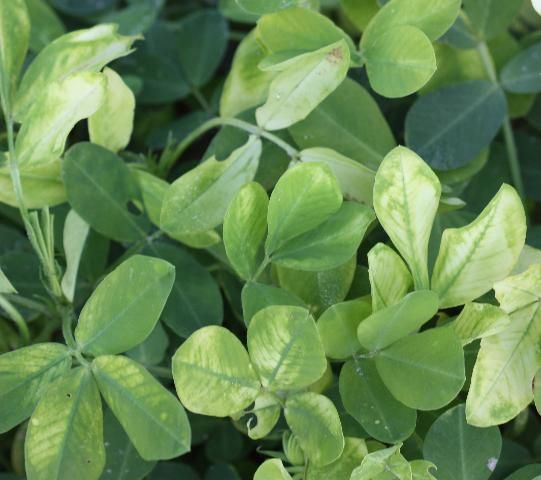
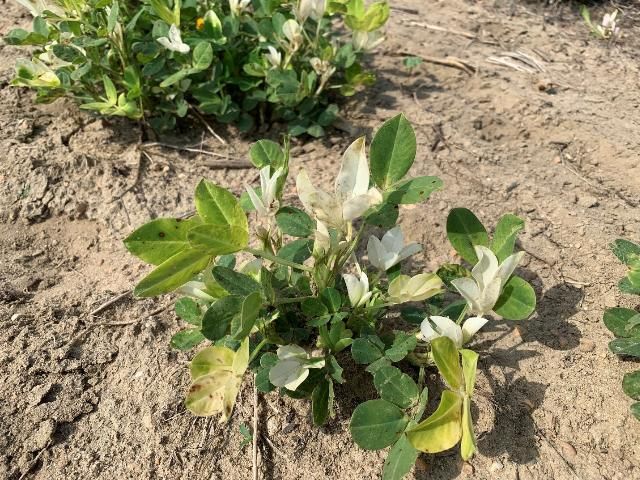
Credit: P. Devkota, UF/IFAS
5) Cell Membrane Disruptors (Group 14)
Mechanism of Action: The cell membrane disruptor herbicides (also called the PPO herbicides) inhibit an enzyme that manufactures chlorophyll. Consequently, accumulation of a pre-chlorophyll molecule, which can accept light energy but cannot pass it to the photosynthesis process, occurs. As a result, energy builds up in the leaf until cell membranes are destroyed. Rapid leaf burning and death occur within 1–3 days, depending on light and weather conditions.
Behavior in Plants: Although many herbicides in this group are labeled only for PRE applications, all these herbicides possess foliar activity as well.
Symptoms: When applied PRE, these herbicides can cause burning of tissue or failed emergence. Bronzing and burning in a speckled pattern are characteristic of these herbicides when applied POST. Injury from cell membrane disruptor herbicides can be easily confused with paraquat injury, but no bronze coloration will be associated with paraquat applications.
Herbicides with This Mode of Action: Flumioxazin (Valor)*, fomesafen, sulfentrazone, lactofen (Cobra)*, carfentrazone, acifluorfen (Ultra Blazer)*
*Labeled in peanut.



6) Seedling Growth Inhibitors (Group 3)
There are two types of seedling growth inhibitors: root inhibitors and shoot inhibitors. They have different modes of action, but both control plants at the seedling stage below the ground.
Dinitroanilines
Mechanism of Action: These herbicides (also known as the DNAs or the yellow herbicides) inhibit root formation in susceptible plants. Root inhibition occurs when the herbicide blocks the process of mitosis (cell division) in the root tip. Affected plants eventually die of drought stress, regardless of soil water status, because they cannot develop sufficient root structure to support the water needs of the leaf and shoot. There is a correlation between oil content of seeds and sensitivity to these herbicides: the higher the seed oil content (e.g., peanut, soybean, etc.), the greater the tolerance. It is difficult to see herbicide injury because peanut seeds have a high oil content. Additionally, peanut taproot is less affected than lateral roots. The peanut taproot may elongate sufficiently to place the apical meristems below the zone of treated soil where lateral roots develop. Therefore, herbicide placement is another factor in crop safety.
Behavior in Plants: The yellow herbicides do not move in plants and only work at the root tip. Roots that extend beyond the treated zone will regain normal growth and development.
Symptoms: Peanut symptoms from these herbicides are short, club-like roots. These symptoms are often associated with high rates of herbicides, improper incorporation (placement), or shallow planting followed by excessive rainfall.
Herbicides with This Mode of Action: Pendimethalin*, trifluralin**, oryzalin, ethalfluralin*
*Labeled in peanut.
**Labeled only in peanuts grown in Texas, Oklahoma, and New Mexico.
Chloroacetamides (Group 15)
Mechanism of Action: These herbicides inhibit several plant processes such as lipid and protein formation.
Behavior in Plants: Chloroacetamides are absorbed into the shoots of emerging plants. The herbicide must be present during emergence to be effective. No activity will be observed from later applications to emerged weeds.
Symptoms: Peanut is generally tolerant to these herbicides, but injury can be observed under certain conditions. The primary symptoms in peanut are root deformation or curling (J-rooting). Symptoms mostly become apparent when peanuts emerge in cool and wet soil conditions. Severely affected plants rarely make a full recovery from initial injury. There is also a leaf burning associated with POST application of these herbicides, but this is due primarily to the solvents in the herbicide formulation. The burning from these applications can be quite obvious, but it usually does not impact peanut growth or development.
Herbicides with This Mode of Action: Metolachlor*, alachlor* (not for use in Florida), dimethenamid*, acetochlor
*Labeled in peanut.
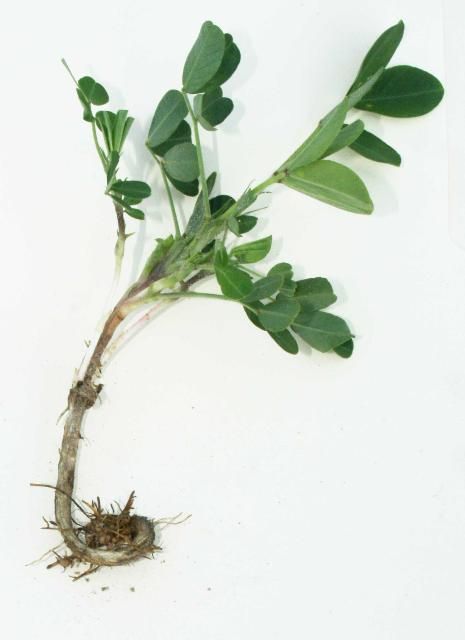

7) Glutamine Synthesis Inhibitor (Group 10)
Mechanism of Action: Glufosinate inhibits the activity of the enzyme that converts glutamate and ammonia into glutamine. Inhibiting this enzyme leads to accumulation of toxic levels of ammonia within the cell. The buildup of ammonia quickly leads to multisystem failure within the photosynthesis pathway and causes irreversible cell damage.
Behavior in Plants: Glufosinate has no soil activity; it only affects plant tissue if it comes in contact with the tissue.
Symptoms: This is a foliar-applied herbicide with contact activity (no movement within the plant). Yellowing and leaf wilting are general symptoms, followed by tissue death. Lesions or burning can be present on affected tissue. Peanut is very sensitive to glufosinate, but injury can be easily mistaken for that associated with paraquat or cell disruptor herbicides.
Herbicides with This Mode of Action: Glufosinate

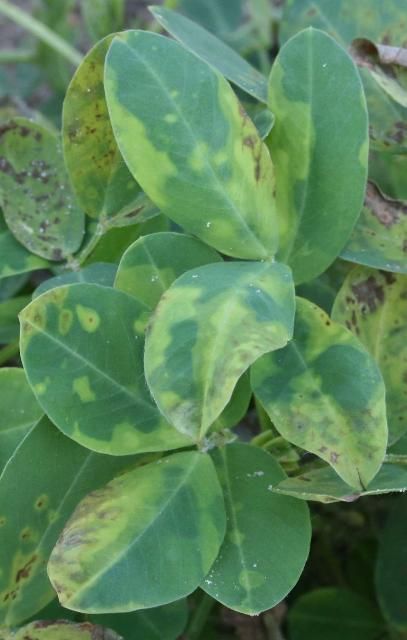


Credit: P. Devkota, UF/IFAS
8) EPSP Synthase Inhibitor (Group 9)
Mechanism of Action: The herbicide from this class inhibits the EPSP enzyme that is responsible for the production of aromatic amino acids (tryptophan, tyrosine, and phenylalanine). Proteins regulate all activity that occurs within a cell, and no proteins can be formed without these essential amino acids. Halting amino acid production slowly starves the plant. Several days or weeks are required before symptoms or plant death are observed.
Behavior in Plants: The herbicide moves within the plant and accumulates in growing points and young leaves.
Symptoms: The most common symptom of glyphosate injury is generalized chlorosis (leaf yellowing) that begins in the newest leaves and progresses to the entire plant. Bleaching can occur. The degree and type of injury observed will depend on application rate and peanut growth stage. Distinguishing glyphosate injury from ALS herbicide injury is difficult, if not impossible. Unless glyphosate injury is severe and persists for several weeks, peanuts generally make a full recovery and experience only slight effects on yield.
Herbicides with This Mode of Action: Glyphosate



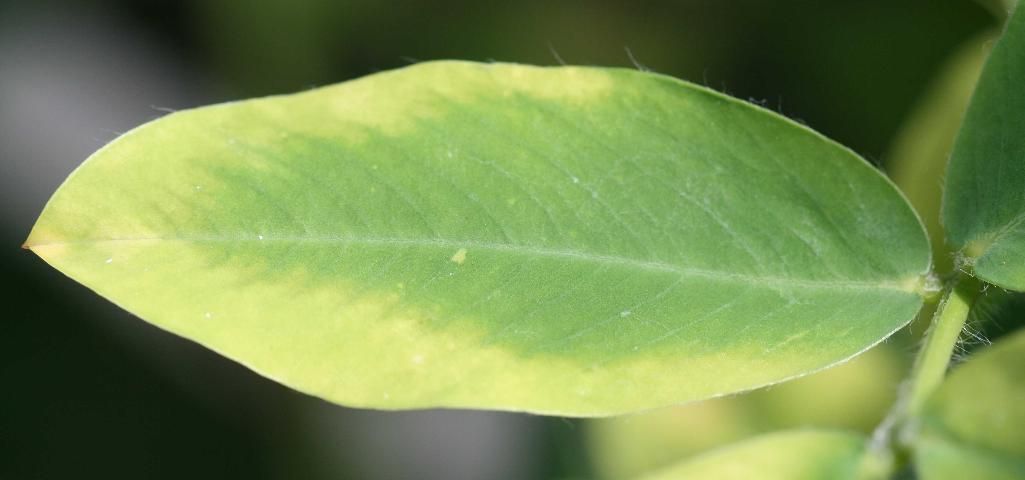


9) Photosystem I Inhibitor (Group 22)
Mechanism of Action: Photosystem I inhibitor herbicide is applied POST with contact or foliar activity. It is rapidly absorbed by green tissue and inhibits photosynthesis. The specific site of action is different from that of atrazine. Photosystem I inhibitor herbicide results in a much more rapid onset of leaf death. Regardless, paraquat causes the formation of radical oxygen, which is toxic to plant cell membranes, within the chloroplast.
Behavior in Plants: The PS I herbicide does not move within the plant and only acts on tissue that it contacts.
Symptoms: Paraquat causes rapid leaf burning on all species present at the time of application. Injury can be confused with that of the cell membrane disruptors or glufosinate. Paraquat can be distinguished from the cell membrane disruptors because paraquat does not result in bronzing around the burned lesion. However, injury symptoms of paraquat and glufosinate are almost indistinguishable. The only difference between the two is that paraquat injury will generally appear within 1 day of application, while glufosinate injury may require 3–4 days to develop symptoms.
Herbicides with This Mode of Action: Paraquat*
*Labeled in peanut.
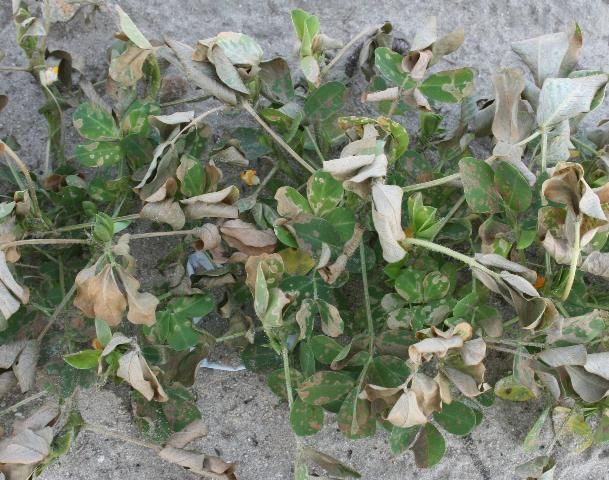

Credit: P. Devkota, UF/IFAS

